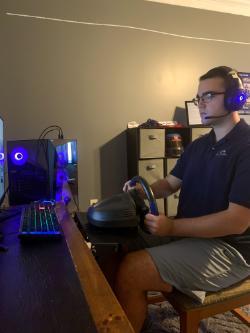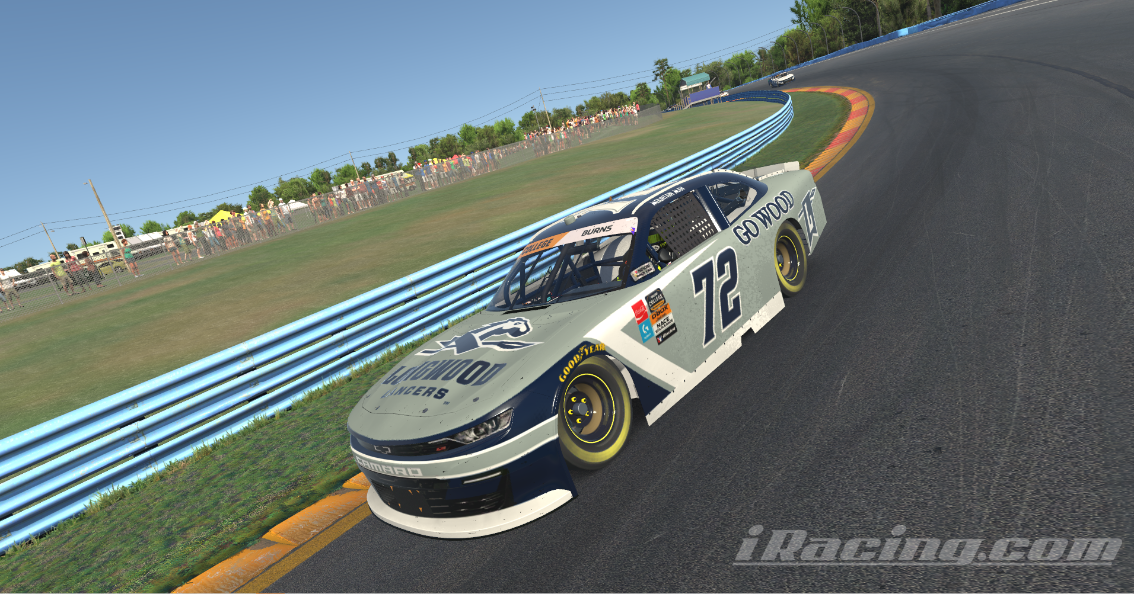On race day, Jeremy Burns ’26 has a routine.
First, he shaves and puts on his Longwood polo shirt. He puts on his headphones, closes his eyes and tries to get energized by the rock music in his ears. He locks his apartment door and takes a last drink of water.
Then he slips behind the wheel of the No. 72 Longwood Lancers Chevrolet Camaro and pushes the pedal to the floor.
Burns, a business major from Bluemont, Virginia, competes in the eNASCAR College iRacing Series, the premier e-sports league for college students across the country, from his Lancer Park apartment. Races are streamed on Twitch and YouTube and regularly draw thousands of viewers from across the country. Winners on the circuit are awarded tens of thousands of dollars in scholarship money.
Currently, Burns sits 38th in the overall points standings halfway through the 2023-24 season.
One of my dreams is to establish a team of iRacers here at Longwood to compete against each other and with each other on the college and professional circuits.
Jeremy Burns ’26 Tweet This

“It’s a real passion of mine,” said Burns. “But I see it as bigger than me. One of my dreams is to establish a team of iRacers here at Longwood to compete against each other and with each other on the college and professional circuits. It’s awesome to see a Longwood car out there rubbing paint with cars from places like Ohio State, Maryland, and UNC. There’s already some interest among fellow students, but I hope to partner with the admissions office, too, maybe to help bring in some people who are just as passionate about iRacing as I am.”
Each college iRacing race is split into three parts. First, hundreds of drivers from across the country—some part of official university teams and others, like Burns, solo drivers representing their schools—log laps in a two-week qualifying period. The drivers with the 40 fastest laps get put in the “A-Main” race, which is most competitive. The next 40 drivers on the list compete in the “B-Main” race.
Just before each race, there is another qualifying session to determine pole position. Once they are in line, the green flag waves and—boogity, boogity, boogity—they are off.
Of the four races so far this season, Burns has made two A-Main races. His best finish came in early December, when he placed 17th at Watkins Glen.
Qualifying is not a given, for any driver.
“At some of the super-speedways like Talladega or Daytona, you’re never letting off the throttle,” he said. “It’s common that the top 40 drivers are separated by a thousandth of a second, so things like setting up your car right and getting as close to the yellow line as possible without touching it during qualifying become huge differentiators. That’s where equipment and experience can make a lot of difference.”
One of the first times he made the A-Main race was as a freshman in 2022, at Daytona International Speedway.
Last year, when I was living in Moss Hall, several friends would set up a watch party in the bedroom next to mine. They’d have the live stream going, and, whenever I would make a pass, I could hear them going crazy.
Jeremy Burns ’26 Tweet This
“Last year, when I was living in Moss Hall, several friends would set up a watch party in the bedroom next to mine,” he said. “They’d have the live stream going, and, whenever I would make a pass, I could hear them going crazy.”
Burns started racing simulation games when he was about 10 years old, when he got a steering wheel as a present from his parents. Being a NASCAR fan, he gravitated toward that style of games— NASCAR 2015 and Project Cars 2, which was the most realistic simulator at the time.
When the Covid pandemic struck during Burns’ sophomore year in high school, NASCAR joined the professional sports leagues trying to figure out new ways to deliver their product. Many of the professional drivers trained in the offseason on iRacing platforms, so they decided to broadcast simulated races, with drivers in state-of-the-art rigs that felt like driving a real car.
“During the pandemic, my family went down to Charlotte to the NASCAR Hall of Fame,” he said. “They had simulators there that the professional drivers were using, and you could do laps on the courses they were driving that week. I set the 37th fastest lap of the week—faster than some of the professional drivers—and from that point, I was hooked. During the races on television, I kept seeing ads for a College iRacing Circuit, and I knew that wherever I went to college, I wanted to compete on that level.”
Compete he has. Heading into the second half of the season, Burns is setting his goals high: Not only does he want to make all four A-Main races to close the season but also to post enough top-20 finishes to earn a spot in the championship race at Homestead, to which only the top 25 drivers are invited. The winner of that race earns a $10,000 scholarship.
“They are lofty goals, but I can see myself getting better and better with each lap,” said Burns. “At the end of the season, I hope they are all looking out for that blue-and-gray Longwood car in their rearview mirrors.”
Qualifying for the next College iRacing Series race at Michigan International Speedway ends on Jan. 16. The race takes place and is streamed live on Twitch and YouTube on Jan. 23.



Leave a Comment